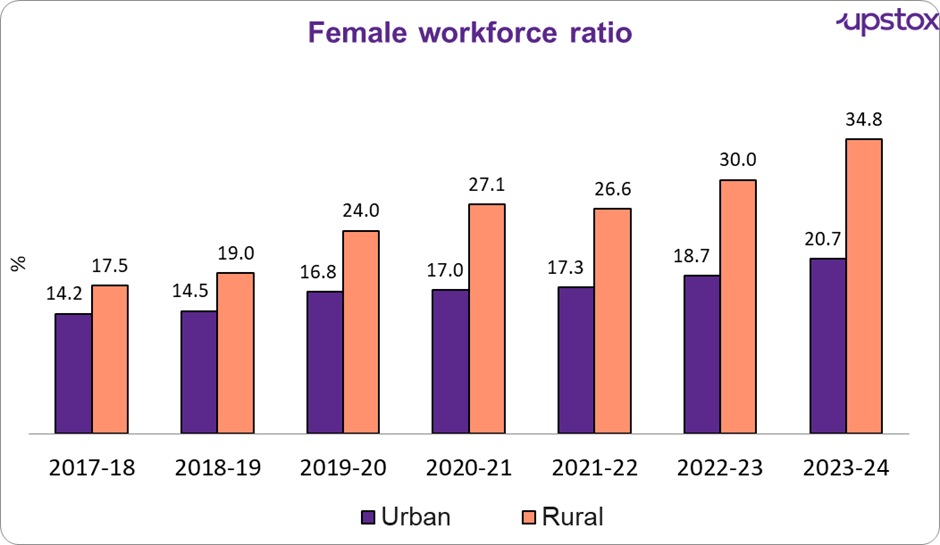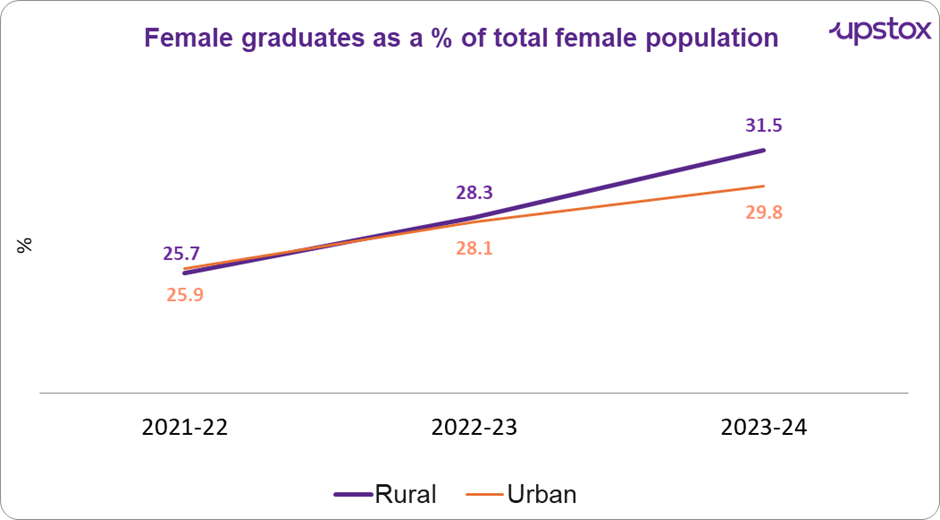Upstox Originals
She means business: Rising female participation in India’s workforce
.png)
9 min read | Updated on January 28, 2025, 18:25 IST
SUMMARY
India is witnessing a remarkable rise in women joining the workforce, driven by improved education, government initiatives, and a shift from agriculture to diverse sectors like services and manufacturing. In this article, we take a deeper look at this trend, breaking it down into urban and rural India. Our research reveals that while the progress is extremely encouraging, India still has a long way to go.

Participation of women in the workforce has increased in rural and urban areas
India has seen a remarkable increase in women joining the workforce. This surge in female participation is not just about numbers it reflects India's commitment to inclusivity and creating opportunities for all.
Let’s look at what the data says. In the last seven years, the urban women workforce has increased by 50% and the rural workforce has doubled. The ratio calculates the number of women as a percent of the total working women.

Source: pib.gov.in, Note: Data for all the above years are between July-June
A key driver of this trend is education, as more women pursue higher education, they are better equipped for professional roles, leading to higher workforce participation. This is particularly evident in the last 3 years as the number of graduates has increased considerably in both rural and urban areas.

Source: pib.gov.in, Note: Data for all the above years are between July-June
Finally, the Government has also come up with many initiatives and policies which are specifically designed to:
-
Enhance women's employability: Includes flagship initiatives like the “Skill India Mission”, focusing on providing industry-relevant skills.
-
Promote women's entrepreneurship: Schemes like “Stand Up India” offer financial support and resources to women, including those from marginalised communities, to start their businesses.
-
Support women in rural areas: The National Rural Livelihood Mission (NRLM) empowers rural women to engage in economic activities, leading to increased participation in both agricultural and non-agricultural sectors.
Let’s dive a bit deeper into how the female workforce is distributed across sectors - across rural and urban areas
Rural areas
As can be seen, agriculture is where the highest percentage of women work. This is due to historically traditional gender roles and economic necessity, which lead many women in rural India to work in agriculture.
With agriculture being the main source of livelihood and support from initiatives like the NRLM, a high percentage of women are employed in this sector.
It is however encouraging to note that the share of women working in agriculture has been coming off. As we mentioned earlier, women’s participation in agriculture has largely been an economic necessity. As such, to see women participate in sectors like construction (the percentage has doubled) and white-collar jobs like hotels is an encouraging development.
We also note that the share of women in Others has gone up meaningfully. We were not able to get our hands on a detailed breakdown of Others - but we have a suspicion a lof these would be white-collar jobs.
Why is this important?
It provides women wider access to different facets of society, provides better access to technology, and aids in holistic development.
Rural area: Women's workforce distribution
| Sectors | 2004-05 | 2009-10 | 2017-18 | 2020-21 | 2023-24 |
|---|---|---|---|---|---|
| Agriculture | 83.3 | 79.4 | 73.2 | 62.2 | 76.9 |
| Mining & quarrying | 0.3 | 0.3 | 0.2 | 0.1 | 0.0 |
| Manufacturing | 8.4 | 7.5 | 8.1 | 10.6 | 8.5 |
| Electricity, water, etc | 0.0 | 0.0 | 0.0 | 0.2 | 0.1 |
| Construction | 1.5 | 5.2 | 5.3 | 5.6 | 3.9 |
| Trade, hotel & restaurant | 2.5 | 2.8 | 4.0 | 6.1 | 3.9 |
| Transport, storage & communications | 0.2 | 0.2 | 0.3 | 1.0 | 0.1 |
| Other services | 3.9 | 4.6 | 8.9 | 14.4 | 6.5 |
| Total | 100.0 | 100.0 | 100.0 | 100.0 | 100.0 |
Source: pib.gov.in, Note: Data for all the above years are between July-June
Scope for improvement
Attendance rates in educational institutions are lower in rural areas compared to urban areas with only 64% of girls aged 15-17 attending, compared to 79% of their counterparts in the urban region.
Additionally, limited access to female-friendly workplaces, safety concerns, and inadequate social welfare mechanisms pose further challenges to women's employment prospects, especially in rural areas
Urban areas
In the case of the urban workforce, steady growth can be seen across multiple sectors such as manufacturing, trade, hotels & restaurants, etc. These sectors are more appealing to women as they offer:
-
Diverse job roles: moving beyond traditional, often physically demanding, agricultural work.
-
Better working conditions: often found in more organised and formal settings.
-
Higher wages: compared to traditional agricultural occupations.
Women in tech jobs
Urban workforce women have also seen an increase in the technology space as a recent report by TeamLease Digital expects it to rise from 25% currently to 35% by 2027. This is driven by the growing demand for skilled workers in exciting fields like quantum computing, blockchain development, and AI.
Urban area: Women's workforce distribution
| Sectors | 2004-05 | 2009-10 | 2017-18 | 2020-21 | 2023-24 |
|---|---|---|---|---|---|
| Agriculture | 18.1 | 13.9 | 9.1 | 10.4 | 12.3 |
| Mining & quarrying | 0.2 | 0.3 | 0.2 | 0.1 | 0.1 |
| Manufacturing | 28.2 | 27.9 | 25.2 | 23.0 | 24.1 |
| Electricity, water, etc | 0.2 | 0.4 | 0.6 | 0.6 | 0.5 |
| Construction | 3.8 | 4.7 | 4.1 | 4.4 | 3.0 |
| Trade, hotel & restaurant | 12.2 | 12.1 | 13.0 | 16.2 | 15.0 |
| Transport, storage & communications | 1.4 | 1.4 | 3.3 | 3.7 | 4.9 |
| Other services | 35.9 | 39.3 | 44.4 | 41.6 | 40.1 |
| Total | 100.0 | 100.0 | 100.0 | 100.0 | 100.0 |
Source: pib.gov.in, Note: Data for all the above years are between July-June
How does India stack up against global peers?
While the developments noted above are definitely encouraging, the truth from a bird’s eye view is however disheartening. As seen in the table below, India is much behind its global peers.
On an even more disappointing note, we even lag behind most of the peers in the developing world.
Percentage of women workforce participation in developed and developing countries
| 2005 (%) | 2010 (%) | 2015 (%) | 2020 (%) | 2023 (%) | |
|---|---|---|---|---|---|
| Developed | |||||
| Canada | 61.7 | 62.4 | 61.2 | 59.5 | 61.1 |
| United States | 58.2 | 57.6 | 56.0 | 55.7 | 56.5 |
| Australia | 57.0 | 58.6 | 59.1 | 60.2 | 61.5 |
| Japan | 48.3 | 48.4 | 49.4 | 53.1 | 54.9 |
| New Zealand | 60.8 | 62.0 | 63.4 | 65.2 | 67.6 |
| Austria | 51.5 | 54.3 | 55.5 | 55.9 | 56.7 |
| Spain | 46.1 | 51.7 | 52.6 | 51.1 | 52.6 |
| Germany | 51.2 | 53.1 | 54.7 | 55.6 | 56.4 |
| France | 50.4 | 51.4 | 51.6 | 50.6 | 52.8 |
| Developing | |||||
| India | 30.1 | 28.8 | 27.0 | 25.9 | 32.7 |
| Thailand | 66.3 | 63.7 | 61.1 | 59.2 | 59.2 |
| Vietnam | 68.6 | 71.6 | 72.5 | 67.9 | 68.5 |
| Indonesia | 46.0 | 50.9 | 50.7 | 53.2 | 53.3 |
| Georgia | 56.0 | 55.8 | 59.0 | 55.1 | 54.4 |
| Nigeria | 56.9 | 56.8 | 54.9 | 51.5 | 52.2 |
| South Africa | 52.4 | 47.0 | 51.0 | 48.7 | 52.4 |
| Sri Lanka | 35.1 | 34.0 | 35.4 | 31.7 | 32.1 |
Source: World Bank Group
Impact of increasing women employees in workforce
A report by McKinsey and LeanIn.org highlights an interesting trend, companies with more women in leadership roles tend to perform better financially. They saw a 47% higher return on equity compared to companies with no women executives. Plus, having more women employees brings in diverse perspectives, experiences, and leadership styles, which boosts organizational health.
Further research also shows that the top 25% of companies known for their gender diversity are 27% more likely to outperform the national industry average in terms of profitability. It’s clear that gender diversity isn't just a feel-good factor it’s a real competitive edge for businesses.
What's the way ahead
To get more women into the workforce, we need to take a well-rounded approach.
-
First off, improving access to quality education, especially in rural areas, is key. It’ll give women the skills they need to take on a variety of job roles.
-
Then, there’s the need for policies that make balancing work and home life easier – think flexible work hours and safer workplaces.
-
Closing the wage gap. In India, by 2022–23, the gender earnings gap was at 76%. Meaning. women were earning 23% lower than the men in the same role. While this has been narrowing, it definitely needs to narrow down further and creating more opportunities for women in leadership positions would also go a long way in encouraging women to pursue professional careers.
-
Lastly, boosting initiatives like “Skill India Mission” and “Stand Up India” can provide the skills and support women need to grow, whether they’re aiming for jobs or starting their own businesses. It’s all about creating the right environment for women to thrive.
-
The latest Periodic Labour Force Survey for 2023-24 paints an interesting picture of female workforce participation across India. Meghalaya, Sikkim, and Himachal Pradesh lead the pack, with almost 70% of their female population actively working.
-
In India, women can take up to 26 weeks of maternity leave for their first two children, which is quite generous. For any children after that, the maximum is 12 weeks. It's reassuring to know that these policies offer more support compared to the 12 weeks in the US and 14 weeks in Europe.
By signing up you agree to Upstox’s Terms & Conditions
About The Author
